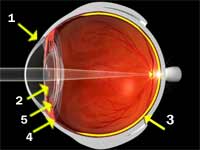Ministry of Health warns: 3d films harm health
So, cheers comrades. What happened was what everyone had been waiting for so long — now you can be a direct participant in the action of the film, you can get into the thick of it, into the very atmosphere of the film — now more and more films are being shot in 3d format. People like it, engineers have a job, companies are dripping $. It seems everyone is happy. But few people think at the expense of what the 3d effect is achieved and that it can actually harm health.

Under the cut, a simple Russian explanation of what harmless three-dimensional picture can harm a simple layman.
Recently, the film industry has seen a boom in 3d. Everyone goes to the movies only on volume, watching flat films seems to be no longer cool. Companies that produce monitors, televisions and video cards are launching a mass production of home equipment for viewing volume. But no one thinks about the possibility of harm. I understand that in our world it’s quite difficult to talk about something harmless, in megacities it’s even harmful to breathe air, not to mention all kinds of devices, like a mobile phone. I am writing this article because, firstly, I think that harm should be minimized, and secondly, because few people think about it. Everyone thought about the dangers of a mobile phone or computer at least once, but about 3d ...
So, let's move on to a wonderful movie theater where they show “Avatar” some next masterpiece in 3d format .

We buy tickets, at the entrance to the hall we check them and give out GLASSES . We joyfully take them and take seats in the hall according to the tickets purchased, wear glasses. And so the long-awaited movie begins. It looks something like this

. Now let's see what happens to our eyes while watching a three-dimensional picture through such glasses. A short lecture on the structure of our eyes. I apologize if it is a little boring.
The lens in our eye is a rather important part of the light-refracting apparatus, it is a kind of lens. There is also a ciliary muscle in the eye.
more details:

1 - cornea
2 - lens
3 - retina
4 - ciliary muscle
5 - cinnamon ligaments
The ciliary muscle is used to stretch and compress the lens, thus, together with the lens, it plays the role of autofocus. When we look at an object, it stretches and contracts (plays with the settings) and, as a result, adjusts to the best focus. This process is called accommodation. In addition to it, there is a range finder in our eye, it works due to the fact that we have 2 eyes, and more or less soberly estimates the distance to objects. Also, the brain without the participation of consciousness can evaluate information about the distance to the object from side sources.
Now the most interesting is how all this stuff works with 3D.
The principle of operation of a three-dimensional movie is to deceive the range finder by technical means, to submit different pictures to different eyes. So, the range finder will be deceived. But what to do with accommodation? She should leave the screen flat! But here begins an even more interesting process - pulling the lens. Autofocus says the subject is in the plane of the screen. The rangefinder says the object is somewhere far away. Consciousness believes parallax (it, like the visual analyzer, is located in the cerebral cortex) and says that the object is far away. The autonomic system receives conflicting directions and begins to go crazy. It ends with the fact that the system either just gets into a stupor (disorientation), or starts to frantically kick up (exit from normal mode and, as a result, overwork).
As a result, with a long viewing of 3D, the ciliary muscle gets tired very quickly (characteristic pain in the eyes, headache). But worst of all is not this, but the fact that the long-standing friendship between the management mechanisms, which until now have always only helped each other, is being destroyed. I don’t know what this leads to, but I hope that in the near future doctors will learn how to treat this thing.
By the way, all that is described above occurs only when viewing 3d near. If the distance to the screen is 10-20 meters. In this case, the lens has the correct position and there are no problems with accommodation.
THEREFORE WATCHING A STEREOKINO RECOMMENDED FROM THE LAST CINEMA SERIES! DO NOT SIT IN FIRST ROWS IN ANY EVENT!
Thanks for attention.

Under the cut, a simple Russian explanation of what harmless three-dimensional picture can harm a simple layman.
Recently, the film industry has seen a boom in 3d. Everyone goes to the movies only on volume, watching flat films seems to be no longer cool. Companies that produce monitors, televisions and video cards are launching a mass production of home equipment for viewing volume. But no one thinks about the possibility of harm. I understand that in our world it’s quite difficult to talk about something harmless, in megacities it’s even harmful to breathe air, not to mention all kinds of devices, like a mobile phone. I am writing this article because, firstly, I think that harm should be minimized, and secondly, because few people think about it. Everyone thought about the dangers of a mobile phone or computer at least once, but about 3d ...
So, let's move on to a wonderful movie theater where they show “

We buy tickets, at the entrance to the hall we check them and give out GLASSES . We joyfully take them and take seats in the hall according to the tickets purchased, wear glasses. And so the long-awaited movie begins. It looks something like this

. Now let's see what happens to our eyes while watching a three-dimensional picture through such glasses. A short lecture on the structure of our eyes. I apologize if it is a little boring.
The lens in our eye is a rather important part of the light-refracting apparatus, it is a kind of lens. There is also a ciliary muscle in the eye.
more details:

1 - cornea
2 - lens
3 - retina
4 - ciliary muscle
5 - cinnamon ligaments
The ciliary muscle is used to stretch and compress the lens, thus, together with the lens, it plays the role of autofocus. When we look at an object, it stretches and contracts (plays with the settings) and, as a result, adjusts to the best focus. This process is called accommodation. In addition to it, there is a range finder in our eye, it works due to the fact that we have 2 eyes, and more or less soberly estimates the distance to objects. Also, the brain without the participation of consciousness can evaluate information about the distance to the object from side sources.
Now the most interesting is how all this stuff works with 3D.
The principle of operation of a three-dimensional movie is to deceive the range finder by technical means, to submit different pictures to different eyes. So, the range finder will be deceived. But what to do with accommodation? She should leave the screen flat! But here begins an even more interesting process - pulling the lens. Autofocus says the subject is in the plane of the screen. The rangefinder says the object is somewhere far away. Consciousness believes parallax (it, like the visual analyzer, is located in the cerebral cortex) and says that the object is far away. The autonomic system receives conflicting directions and begins to go crazy. It ends with the fact that the system either just gets into a stupor (disorientation), or starts to frantically kick up (exit from normal mode and, as a result, overwork).
As a result, with a long viewing of 3D, the ciliary muscle gets tired very quickly (characteristic pain in the eyes, headache). But worst of all is not this, but the fact that the long-standing friendship between the management mechanisms, which until now have always only helped each other, is being destroyed. I don’t know what this leads to, but I hope that in the near future doctors will learn how to treat this thing.
By the way, all that is described above occurs only when viewing 3d near. If the distance to the screen is 10-20 meters. In this case, the lens has the correct position and there are no problems with accommodation.
THEREFORE WATCHING A STEREOKINO RECOMMENDED FROM THE LAST CINEMA SERIES! DO NOT SIT IN FIRST ROWS IN ANY EVENT!
Thanks for attention.
